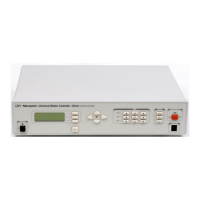require it. The driver, motor, motion device and load undergo
maximum stress during high acceleration.
5.2.16 Combined Parameters
Very often a user looks at an application and concludes that they need
a certain overall accuracy. This usually means that the user is
combining a number of individual terms (error parameters) into a
single one. Some of this combined parameters even have their own
name, even though not all people mean the same thing by them:
Absolute Accuracy, Bi-directional Repeatability, etc. The problem
with these generalizations is that, unless the term is well defined and
the testing closely simulates the application, the numbers could be of
little value.
The best approach is to carefully study the application, extract from
the specification sheet the applicable discrete error parameters and
combine them (usually add them) to get the worst-case general error
applicable to the specific case. This method not only offers a more
accurate value but also gives a better understanding of the motion
control system performance and helps pinpoint problems.
Also, due to integrated nature of the ESP300 system, many basic
errors can be significantly corrected by another component of the
loop. Backlash, Accuracy and Velocity Regulation are just a few
examples where the controller can improve motion device
performance.
5.3 Control Loops
When talking about motion control systems, one of the most
important questions is the type of servo loop implemented. The first
major distinction is between open and closed loops. Of course, this is
of particular interest when driving stepper motors. As far as the DC
servo loops, the PID type is by far the most widely used.
The ESP300 implements a PID servo loop with velocity and
acceleration feed-forward.
The basic diagram of a servo loop is shown in (
Figure 5.13). Besides
the command interpreter, the main two parts of a motion controller
are the trajectory generator and the servo controller. The first
generates the desired trajectory and the second one controls the motor
to follow it as closely as possible.
Section 5 – Motion Control Tutorial 5-13

